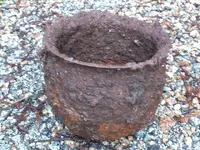H
Holly_squirrel
Guest
- #1
Thread Owner
I'm pretty new to all this. I have a garret ace 250. I notice most relics I find bounce from low to high scale and everywhere Inbetween . I understand that is due to iron and rust recording differently.... But sometimes a nail will resister the same way. How do I avoid wasting time digging up nails and not miss a good relic? I'm almost a scared to not dig up a pretty solid hit that bounces on the lower end with a spike or two at the high end.
But my yard is paying tbe price, looks like I got gophers.
And sometimes I get a nice solid hit towards tbe silver end and soon as I turn back a layer of soul, it's gone... that's with me carefully dissecting the dirt... And seeing nothing... The signal just goes dead .
But my yard is paying tbe price, looks like I got gophers.
And sometimes I get a nice solid hit towards tbe silver end and soon as I turn back a layer of soul, it's gone... that's with me carefully dissecting the dirt... And seeing nothing... The signal just goes dead .
Last edited:








